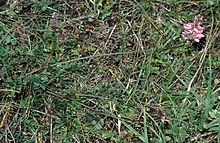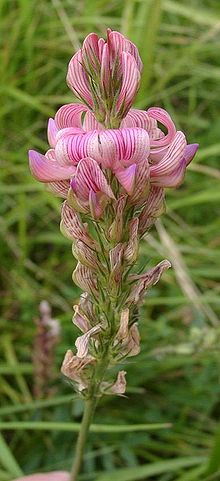- Onobrychis
-
"Sainfoin" redirects here. For Royal Navy ship, see HMS Sainfoin (F183).
Onobrychis 
Flowering Onobrychis arenaria Scientific classification Kingdom: Plantae (unranked): Angiosperms (unranked): Eudicots (unranked): Rosids Order: Fabales Family: Fabaceae Subfamily: Faboideae Tribe: Hedysareae Genus: Onobrychis
Mill.Species Some 140-150, see text.
Synonyms Dendrobrychis (DC.) Galushko
Xanthobrychis GalushkoOnobrychis, the Sainfoins, are Eurasian perennial herbs of the legume family (Fabaceae). Including doubtfully distinct species and provisionally accepted taxa, about 150 species are presently known. The Flora Europaea lists 23 species of Onobrychis; the main centre of diversity extends from Central Asia to Iran, with 56 species – 27 of which are endemic – in the latter country alone.[1] O. viciifolia is naturalized throughout many countries in Europe and North America grasslands on calcareous soils.
Description, ecology and uses
Sanfoins are mostly subtropical plants, but their range extends throughout Europe as far north as southern Sweden. These plants grow on grassland, agricultural land and wasteland. The leaves are pinnate, alternate, with 6 to 14 pairs of oblong to linear leaflets. Sainfoins have pale pink flowers, typically blooming between June and September and pollinated by honey bees and solitary bees. The rounded single-seeded pods bear prominent spikes or similar protrusions in many species, enabling them to cling to the fur of large mammals and be thus distributed.
These highly nutritious plants were an important forage for heavy working horses in agriculture, and are still an excellent source of nectar for honey production as well as pollen for bee food. Because sanfoins are rich in tannins which protect proteins from hydrolysis in the rumen, the proteins are instead absorbed in the abomasum. Onobrychis typically have a deep taproot and so are very drought resistant, but do not recover well from overgrazing. Adapted to slow but steady growth in the arid steppe belt of Eurasia, sainfoins are difficult to establish as pasture, are not persistent in grassland, and only yield one crop of hay or seeds per year. Thus they are seldom grown in any significant extent, though O. viciifolia is met with somewhat more regularly.
Onobrychis species are used as food plants by the caterpillars of some Lepidoptera species, such as the case-bearer moth Coleophora colutella (recorded on O. saxatilis) and the Damon Blue (Polyommatus damon) butterfly.
Etymology
Onobrychis means "devoured by donkeys", from Ancient Greek ónos (ὄνος, "donkey") and brýkein (βρύκειν, "to eat greedily"). This refers to sainfoin's good properties as a forage plant for large mammalian herbivores.
Sainfoin is derived from Old French sain foin ("healthy hay"). In the words of the 16th-century soil scientist Olivier de Serres:
"The herb is called sain-foin in France, in Italy herba medica, in Provence and the Languedoc luzerne. From the inordinate praise the plant has been given, for its medical virtues and for fattening the livestock that graze on it, comes the term sain."[2]
In northern European languages that have been less influenced by French, the plants' name usually derives from esparceto, the Provençal term for the similar-looking and closely related sweetvetches (Hedysarum). Examples are Danish esparsette, Dutch esparcette, German Esparsette, Lithuanian esparceta, Polish sparceta, Russian espartset (Эспарцет) and Swedish esparsett. Meanwhile, the Occitan name of sainfoin, luzerne, has in many languages come to mean species of the related genus Medicago, in particular Alfalfa (M. sativa).
The native name of the Cock's Head (O. caput-galli) is one of the few words of the extinct Dacian language that have been recorded. The Dacians called this plant aniarsexe or aniassexie.
In George Orwell's Coming Up for Air, travelling salesman George Bowling regularly reminisces about the smell of sainfoin in his father's seed shop in Lower Binfield.
List of species
The following species are considered at least provisionally valid by the International Legume Database & Information Service; some notable subspecies are also listed:[3]
 Seedpods of various Onobrychis species:
Seedpods of various Onobrychis species:
1) O. hypargyrea, 2) O. pallasii, 3) O. radiata[verification needed]
4) O. petraea[verification needed], 5) O. supina, 6) O. gracilis, 7) O. stenorhiza, 8) O. montana, 12) O. oxyodonta, 14) O. inermis, 15) Cock's Head (O. caput-galli), 16) O. aequidentata- Onobrychis acaulis Bornm.
- Onobrychis aequidentata (Sm.) d'Urv.
- Onobrychis afghanica Sirj. & Rech.f.
- Onobrychis alatavica Bajtenov
- Onobrychis alba (Waldst. & Kit.) Desv.
- Onobrychis alba ssp. calcarea (Vandas) P.W.Ball
- Onobrychis aliacmonia Rech.f.
- Onobrychis altissima Grossh.
- Onobrychis alyassinicus Parsa
- Onobrychis amoena Popov & Vved.
- Onobrychis andalanica Bornm.
- Onobrychis angustifolia Chinth. (= O. petrae sensu auct. fl. Cauc.)
- Onobrychis arenaria (Kit.) DC.
- Onobrychis arenaria ssp. arenaria (= O. tanaitica Spreng., O. viciifolia sensu auct. fl. Ross.)
- Onobrychis arenaria ssp. sibirica (Besser) P.W.Ball (= O. tanaitica sensu auct. non Spreng.)
- Onobrychis arenaria ssp. tommasinii (Jord.) Asch. & Graebn.
- Onobrychis argyrea Boiss. (= O. ornata)
- Onobrychis arnacantha Boiss.
- Onobrychis atropatana Boiss. (=? O. heterophylla sensu Trautv.)
- Onobrychis aucheri Boiss.
- Onobrychis baldshuanica Sirj.
- Onobrychis bertiscea Sirj. & Rech.f.
- Onobrychis bicornis Vassilcz. (validity requires confirmation)
- Onobrychis biebersteinii Sirj. (= O. sativa sensu Ledeb.)
- Onobrychis bobrovii Grossh.
- Onobrychis buhseana Boiss.
- Onobrychis "buhseana" Bunge (validity requires confirmation)
- Onobrychis bungei Boiss.
- Onobrychis cadevallii Jahand. et al.
- Onobrychis caput-galli (L.) Lam. Cock's Head
- Onobrychis chorassanica Boiss. (= O. circinnata sensu auct. fl. As. Med. non Ledeb., O. radiata sensu auct. fl. As. Med., O. vaginalis sensu auct. fl. As. Med.)
- Onobrychis conferta (Desf.) Desv.
- Onobrychis conferta ssp. hispanica (Sirj.) Guitt. & Kerguelen
- Onobrychis cornuta (L.) Desv.
- Onobrychis crista-galli (L.) Lam.
- Onobrychis cyri Grossh. (=? O. viciaefolia sensu Trautv.)
- Onobrychis daghestanica Grossh.
- Onobrychis darwasicaa Vassilcz.
- Onobrychis dealbata Stocks
- Onobrychis degenii Dorfl.
- Onobrychis depauperata Boiss.
- Onobrychis dielsii (Sirj.) Vassilcz.
- Onobrychis ebenoides Boiss. & Spruner
- Onobrychis echidna Lipsky
- Onobrychis elymaitiaca Boiss. & Hausskn.
- Onobrychis eubrychidea Boiss.
- Onobrychis fallax Freyn & Sint.
- Onobrychis ferganica (Sirj.) Grossh.
- Onobrychis freitagii Rech.f.
- Onobrychis galegifolia Boiss.
- Onobrychis gaubae Bornm.
- Onobrychis gontscharovii Vassilcz. (= O. lipskyi sensu auct. non Korovin)
- Onobrychis gracilis Besser (= O. longeaculeata (Pacz.) Wissjul., O. petrae sensu Besser)
- Onobrychis grandis Lipsky
- Onobrychis grossheimii B.Fedtsch.
- Onobrychis gypsicola Rech.f.
- Onobrychis hajastana Grossh.
- Onobrychis hamata Vassilcz.
- Onobrychis haussknechtii Boiss.
- Onobrychis heliocarpa Boiss.
- Onobrychis heterophylla C.A.Mey.
- Onobrychis hohenackerana C.A.Mey.
- Onobrychis humilis (Loefl.) G.López
- Onobrychis humilis ssp. humilis
- Onobrychis humilis ssp. matritensis (Boiss. & Reut.) Greuter & Burdet (= O. longeaculeata (Boiss.) Pau)
- Onobrychis hypargyrea Boiss.
- Onobrychis iberica Grossh.
- Onobrychis inermis Steven
- Onobrychis iranica Bornm.
- Onobrychis iranshahrii Rech.f.
- Onobrychis jailae Czernova
- Onobrychis kabylica (Bornm.) Sirj.
- Onobrychis kachetica Boiss. & Buhse
- Onobrychis kemulariae Chinth. (= O. biebersteinii sensu auct. fl. Cauc.)
- Onobrychis kermanensis (Sirj. & Rech.f.) Rech.f.
- Onobrychis kluchorica Chinth.
- Onobrychis komarovii Grossh.
- Onobrychis kotschyana Fenzl
- Onobrychis lahidjanicus Parsa
- Onobrychis laxiflora Baker (=? O. schugnanica)
- Onobrychis longipes Bunge
- Onobrychis lunata Boiss.
- Onobrychis luristanica Rech.f.
- Onobrychis macrorrhiza Rech.f.
- Onobrychis major (Boiss.) Hand.-Mazz.
- Onobrychis majorovii Grossh.
- Onobrychis mazanderanica Rech.f.
- Onobrychis megalobotrys Aitch. & Hemsl. (= O. vaginalis sensu auct. non C.A.Mey. non fl. As. Med.)
- Onobrychis megaloptera Kovalevsk. (=? O. chorassanica sensu Nikitina)
- Onobrychis megataphros Boiss.
- Onobrychis melanotricha Boiss. (=? O. belangeri, =? O. linearis)
- Onobrychis mermuelleri Podlech & Rech.f.
- Onobrychis meschetica Grossh.
- Onobrychis michauxii DC.
- Onobrychis micrantha Schrenk
- Onobrychis microptera Baker
- Onobrychis montana DC.
- Onobrychis nemecii Sirj.
- Onobrychis nikitinii Orazm.
- Onobrychis novopokrovskii Vassilcz.
- Onobrychis nummularia Boiss.
- Onobrychis oxyodonta Boiss.
- Onobrychis oxyptera Boiss.
- Onobrychis oxytropoides Bunge
- Onobrychis pallasii (Willd.) M. Bieb.
- Onobrychis pallida Boiss. & Kotschy
- Onobrychis paucidentata Pomel (validity requires confirmation)
- Onobrychis persica Sirj. & Rech.f.
- Onobrychis petraea (Willd.) Fisch.
- Onobrychis pindicola Hausskn.
- Onobrychis plantago Bornm.
- Onobrychis poikilantha Rech.f.
- Onobrychis psoraleifolia Boiss.
- Onobrychis ptolemaica (Delile) DC.
- Onobrychis ptychophylla Sirj. & Rech.f.
- Onobrychis pulchella Schrenk
- Onobrychis pyrenaica (Sennen) Sirj.
- Onobrychis radiata (Desf.) M.Bieb. (= O. circinata Ledeb.
- Onobrychis rechingerorum Wendelbo
- Onobrychis reuteri Leresche
- Onobrychis ruprechtii Grossh.
- Onobrychis samanganica Rech.f.
- Onobrychis saravschanica B.Fedtsch. (= O. amoena sensu auct. non Popov & Vved., O. baldshuanica sensu auct. non Sirj., O. baldzuanica Sirj., O. circinata sensu auct. non Ledeb. non fl. As. Med.)
- Onobrychis sauzakensis Sirj. & Rech.f.
- Onobrychis saxatilis (L.) Lam.
- Onobrychis schahuensis Bornm.
- Onobrychis schuschajensis O.D.Agajeva
- Onobrychis scrobiculata Boiss.
- Onobrychis sennenii Sirj.
- Onobrychis shahpurensis Rech.f.
- Onobrychis sintenisii Bornm.
- Onobrychis sirdjanicus Parsa
- Onobrychis sojakii Rech.f.
- Onobrychis sphaciotica Greuter
- Onobrychis spinosissima Baker
- Onobrychis splendida Rech.f. & Podlech
- Onobrychis stenorhiza DC.
- Onobrychis stewartii Baker
- Onobrychis subacaulis Boiss.
- Onobrychis subnitens Bornm.
- Onobrychis supina (Vill.) DC.
- Onobrychis susiana Nabelek
- Onobrychis szovitsii Boiss.
- Onobrychis talagonica Rech.f.
- Onobrychis tavernieraefolia Boiss.
- Onobrychis tesquicola Krytzka
- Onobrychis tournefortii (Willd.) Desv.
- Onobrychis transcaspica V.V.Nikitin
- Onobrychis transcaucasica Grossh.
- Onobrychis transsilvanica
- Onobrychis vaginalis C.A.Mey.
- Onobrychis vassilczenkoi Grossh.
- Onobrychis verae Sirj. (= O. lipskyi Korovin)
- Onobrychis viciifolia Scop. (= O. sativa Lam.)
- Onobrychis wettsteinii Nabelek
Footnotes
References
- International Legume Database & Information Service (ILDIS) (2005): Genus Onobrychis. Version 10.01, November 2005. Retrieved 2009-JAN-26.
- Muẓaffariyān, Valī Allāh (1996): Farhang-i nāmhā-yi giyāhān-i Īrān: Lātīnī, Inglīsī, Fārsī ["A dictionary of Iranian plant names: Latin, English, Persian"]. Tehran: Farhang-i Muʻāṣir [in Persian with Latin and English names]. ISBN 9645545196
Categories:- Hedysareae
Wikimedia Foundation. 2010.


